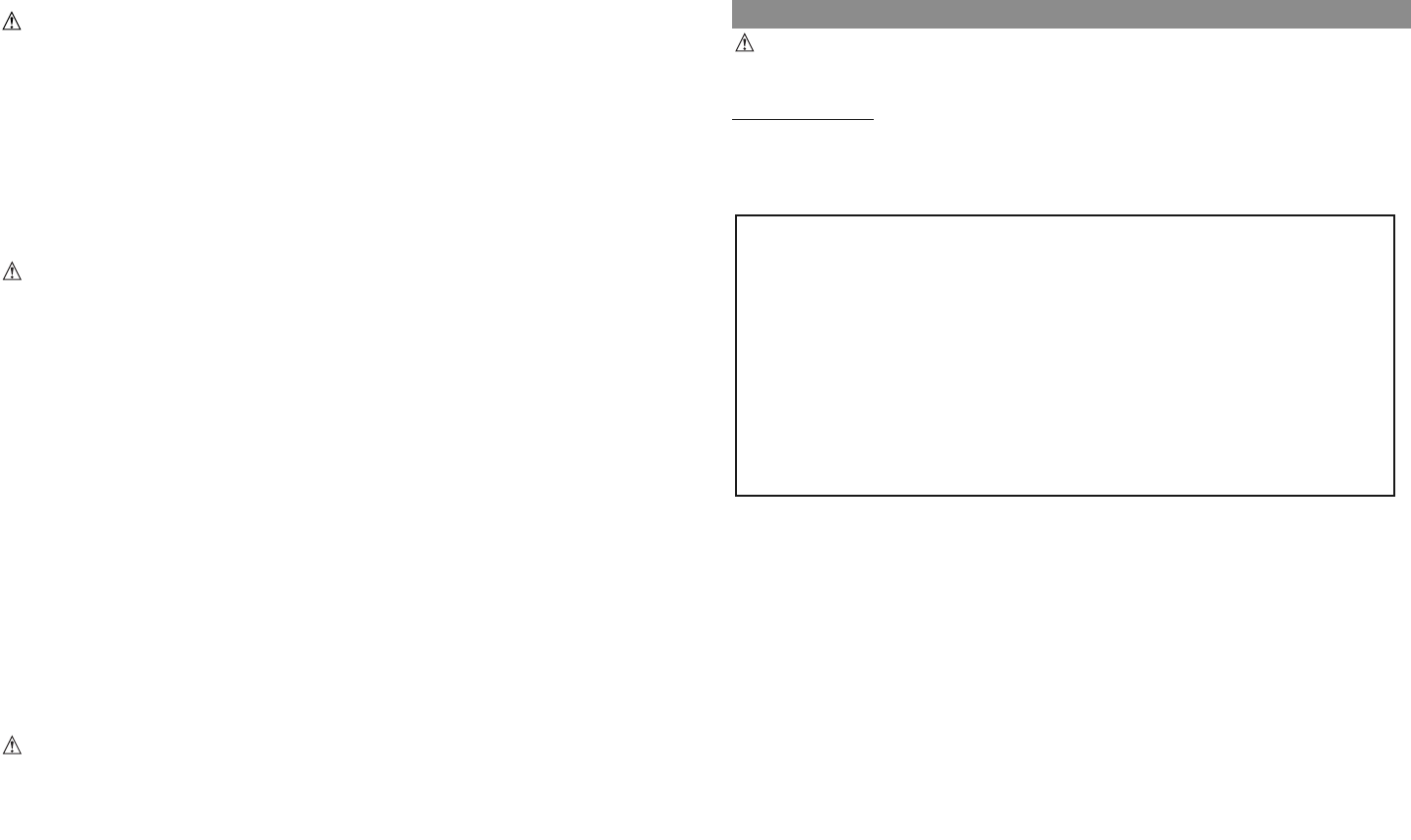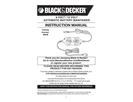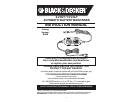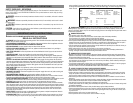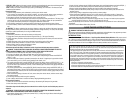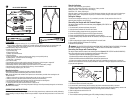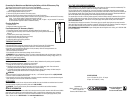• FIRST AID – SKIN: If battery acid comes in contact with skin, rinse immediately with water, then wash thoroughly with
soap and water. If redness, pain, or irritation occurs, seek immediate medical attention.
EYES: If battery acid comes in contact with eyes, flush eyes immediately, for a minimum of 15 minutes and seek
immediate medical attention.
Preparing to Charge
1. Determine voltage of battery to be maintained by referring to the vehicle manual.
2. If it is necessary to remove battery from vehicle to maintain , or to clean terminals, always remove grounded ter-
minal from battery first. Make sure all accessories in the vehicle are off, so as not to cause an arc.
3. Clean battery terminals. Do not allow corrosion to come in contact with eyes.
4. Add distilled water in each cell until battery acid reaches level specified by battery manufacturer. This helps purge
excessive gas from cells. Do not overfill and always replace caps. For a battery without cell caps (maintenance
free), carefully follow battery manufacturer's charging and maintenance instructions.
5. Study all battery manufacturer’s specific precautions, while charging, and recommended rates of charge.
6. Area around battery should be well ventilated while battery is being charged. Do not operate within an enclosed
area.
CAUTION: This battery maintainer does not detect, diagnose or analyze the condition of the battery. Attempting
to charge/maintain a battery with an abnormal condition can further damage the battery. If in doubt, have the battery
checked by a qualified professional prior to using the BM3B maintainer.
Charger Location
1. Locate battery maintainer as far away from battery as cables permit.
2. Charge above freezing temperature and below 40 degree Celsius (C) (104 degree Fahrenheit).
3. NEVER place battery maintainer directly above battery being charged; gases from battery will corrode and dam-
age charger.
4. NEVER allow battery acid to drip on battery maintainer when reading gravity or filling battery.
5. NEVER operate battery maintainer in a closed-in area or restrict ventilation in any way.
6. Marine batteries must be removed and charged on shore.
7. Do not set a battery on top of battery maintainer.
Follow these steps when the battery is installed in a vehicle. A spark near the battery may cause an explosion.
WARNING: TO REDUCE RISK OF A SPARK NEAR THE BATTERY: CONNECT AND DISCONNECT DC OUTPUT
CLAMPS AND RING TERMINALS ONLY AFTER REMOVING AC CORD FROM ELECTRIC OUTLET.
1. Position AC and DC cords away from hood, door, or moving engine parts.
2. Stay clear of fan blades, belts, pulleys, and other parts that can cause injury to persons.
3. Check polarity of battery posts. POSITIVE (POS, P, +) battery post usually has larger diameter than NEGATIVE
(NEG, N, –) post.
4. Determine which post of battery is grounded (connected) to the chassis. If negative post is grounded to chassis
(as in most vehicles), see 5. If positive post is grounded to the chassis, see 6.
5. For negative-grounded vehicle, connect POSITIVE (RED) clamp from battery charger to POSITIVE (POS, P, +) un-
grounded post of battery. Connect NEGATIVE (BLACK) clamp to vehicle chassis or engine block away from bat-
tery. Do not connect clip to carburetor, fuel lines, or sheet-metal body parts. Connect to heavy gauge metal part of
the frame or engine block.
6. For positive-grounded vehicle, connect NEGATIVE (BLACK) clamp from battery charger to NEGATIVE (NEG, N, –)
ungrounded post of battery. Connect POSITIVE (RED) clamp to vehicle chassis or engine block away from battery.
Do not connect clip to carburetor, fuel lines or sheet-metal body parts. Connect to a heavy gauge metal part of the
frame or engine block.
7. When disconnecting charger, disconnect AC cord, remove clamp from vehicle chassis, and then remove clamp
from battery terminal.
8. Do not charge the battery while the engine is operating.
9. Refer to battery manufacturer's instruction on battery charging/maintaining procedures.
DC Connection Precautions
1. Remove AC cord from electric outlet before connecting or disconnecting DC clamps and ring terminals.
2. Never allow clamps to touch each other.
Follow these steps when the battery has been removed from a vehicle. A spark near the battery may cause an
explosion.
WARNING: TO REDUCE RISK OF A SPARK NEAR THE BATTERY: CONNECT OR DISCONNECT DC OUTPUT
CLAMPS ONLY AFTER REMOVING AC CORD FROM ELECTRICAL OUTLET.
1. Check polarity of battery posts. Positive post (marked POS,P, +) usually has a larger diameter than the Negative
battery post (marked NEG, N, –).
2. Attach a 24-inch (minimum length) 6 AWG insulated battery cable to the Negative battery post (marked NEG, N, –).
3. Connect the Positive (RED) battery clamp to the Positive battery post (marked POS, P, + or red).
4. Stand as far back from the battery as possible, and do not face battery when making final connection.
5. Carefully connect the NEGATIVE (BLACK) charger clamp to the free end of the battery cable connected to the
negative terminal.
6. Set the charge voltage to appropriate setting according to battery voltage .
7. When disconnecting maintainer, always do so in reverse sequence of connecting procedure. Remove the
connection from the 6AWG cable (mentioned in step #2) as far away from the battery as possible. Break first
connection while as far away from battery as practical.
Note: A marine (boat) battery must be removed and charged on shore. To charge it on board requires equipment
specially designed for marine use. This unit is NOT designed for such use.
• Check unit periodically for wear and tear. Take to a qualified technician for replacement of worn or defective parts
immediately.
• Read This Instruction Manual Before Using This Unit.
SAVE THESE INSTRUCTIONS
WARNING: TO REDUCE THE RISK OF INJURY:
Follow these instructions and those published by the battery manufacturer and manufacturer of any equipment you intend
to use with this unit. Review cautionary markings on these products and on engine.
INTRODUCTION
Thank you for selecting the
Black & Decker
®
1 Amp Charge Rate Automatic Battery Maintainer.
With proper care and
use, it will give you years of dependable service. Please read and observe all safety warnings and cautions and this en-
tire user’s instruction manual, before installing or using this device. The instruction manual should then be retained for
quick reference whenever the unit is used. Figure 1 shows the battery maintainer and its components.
4 5
This device complies with part 15 of the FCC rules. Operation is subject to the following two conditions: (1)
this device may not cause harmful interference, and (2) this device must accept any interference received,
including interference that may cause undesired operation.
This equipment has been tested and found to comply with the limits for a Class B digital device, pursuant to
part 15 of the FCC Rules. This limits are designed to provide reasonable protection against harmful interfer-
ence in a residential installation. This equipment generates, uses and can radiate radio frequency energy and,
if not installed and used in accordance with the instructions, may cause harmful interference to radio com-
munications. However, there is no guarantee that interference will not occur in a particular installation. If
equipment does cause harmful interference to radio or television reception, which can be determined by turn-
ing the equipment off and on, the user is encouraged to try to correct the interference by one or more of the
following measures:
• Reorient or relocate the receiving antenna.
• Increase the separation between equipment and receiver.
• Connect the equipment into an outlet on a circuit different from that to which the receiver is connected.
• Consult the dealer or an experienced radio/TV technician for help.












